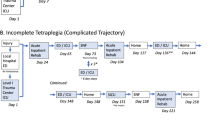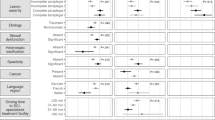Abstract
Study design:
Online survey.
Objectives:
To understand the prevailing scenario of the comprehensive management of spinal cord injuries (SCI) in India and in the Asian Spinal Cord Network (ASCoN) region, especially with a view to document the challenges faced and its impact.
Setting:
Indian Spinal Injuries Centre.
Methods:
A questionnaire was designed which covered various aspects of SCI management. Patients, consumers (spinal injured patients discharged since at least 1 year) and experts in SCI management from different parts of India and the ASCoN region were approached to complete the survey.
Results:
Sixty patients, 66 consumers and 34 experts completed the survey. Difference of opinion was noticed among the three groups. Disposable Nelaton catheters were used by 57% consumers and 47% patients. For reusable catheter, 31% experts recommended processing with soap and running water and 45% recommended clean cotton cloth bag for storage. Pre-hospital care and community inclusion pose the biggest challenges in management of SCI. More than 75% of SCI faced problems of access and mobility in the community. Awareness about SCI, illiteracy and inadequate patient education are the most important factors hindering pre- and in-hospital care. Inadequate physical as well as vocational rehabilitation and financial barriers are thought to be the major factors hindering integration of spinal injured into mainstream society. Strong family support helped in rehabilitation.
Conclusions:
Our study brought out that SCI in India and ASCoN region face numerous challenges that affect access to almost all aspects of comprehensive management of SCI.
Similar content being viewed by others
Log in or create a free account to read this content
Gain free access to this article, as well as selected content from this journal and more on nature.com
or
References
Donovan WH . Donald Munro Lecture. Spinal cord injury—past, present, and future. J Spinal Cord Med 2007; 30: 85–100.
Whalley Hammell K . Quality of life after spinal cord injury: a meta-synthesis of qualitative findings. Spinal Cord 2007; 45: 124–139.
Rathore MFA. Spinal Cord Injuries in the Developing World. In: International Encyclopedia of Rehabilitation. Center for International Rehabilitation Research Information and Exchange (CIRRIE)., 2010..
Chhabra HS, Arora M . Neglected traumatic spinal cord injuries: causes, consequences and outcomes in an Indian setting. Spinal Cord 2013; 51: 238–244.
Rathore MFA, Rashid P, Butt AW, Malik AA, Gill ZA, Haig AJ . Epidemiology of spinal cord injuries in the 2005 Pakistan earthquake. Spinal Cord 2007; 45: 658–663.
Pandey V, Nigam V, Goyal TD, Chhabra H . Care of post-traumatic spinal cord injury patients in India: an analysis. Indian J Orthop 2007; 41: 295–299.
Scovil CY, Ranabhat MK, Craighead IB, Wee J . Follow-up study of spinal cord injured patients after discharge from inpatient rehabilitation in Nepal in 2007. Spinal Cord 2012; 50: 232–237.
Hansen CH, Mahmud I, Bhuiyan AJ . Vocational reintegration of people with spinal cord lesion in Bangladesh – an observational study based on a vocational training project at CRP. Asia Pac Disabil Rehabil J 2007; 18: 63–75.
Chiu W-T, Lin H-C, Lam C, Chu S-F, Chiang Y-H, Tsai S-H . Review paper: epidemiology of traumatic spinal cord injury: comparisons between developed and developing countries. Asia Pac J Public Health 2010; 22: 9–18.
Nilsen ES, Myrhaug HT, Johansen M, Oliver S, Oxman AD . Methods of consumer involvement in developing healthcare policy and research, clinical practice guidelines and patient information material. Cochrane Database Syst Rev 2006; 3: CD004563.
Wyndaele M, Wyndaele J-J . Incidence, prevalence and epidemiology of spinal cord injury: what learns a worldwide literature survey? Spinal Cord 2006; 44: 523–529.
Hyun I, Lindvall O, Ährlund-Richter L, Cattaneo E, Cavazzana-Calvo M, Cossu G et al. New ISSCR guidelines underscore major principles for responsible translational stem cell research. Cell Stem Cell 2008; 3: 607–609.
Rathore MFA, Hanif S, Farooq F, Ahmad N, Mansoor SN . Traumatic spinal cord injuries at a tertiary care rehabilitation institute in Pakistan. J Pak Med Assoc 2008; 58: 53–57.
Ng HJ, Lee LH . Trends in prevalence of deep venous thrombosis among hospitalised patients in an Asian institution. Thromb Haemost 2009; 101: 1095–1099.
Halim TA, Chhabra HS, Arora M, Kumar S . Pharmacological prophylaxis for deep vein thrombosis in acute spinal cord injury: an Indian perspective. Spinal Cord 2014; 52: 547–550.
Wells JD, Nicosia S . The effects of multidisciplinary team care for acute spinal cord injury patients. J Am Paraplegia Soc 1993; 16: 23–29.
Haig A, Im J, Adewole D, Nelson V, Krabak B . The practice of physical and rehabilitation medicine in sub-Saharan Africa and Antarctica: a white paper or a black mark? J Rehabil Med 2009; 41: 401–405.
Rathore FA . Neglected traumatic spinal cord injuries: experience sharing from Pakistan. Spinal Cord 2013; 51: 652–653.
Linsenmeyer TA, Linsenmeyer MA . Impact of annual urodynamic evaluations on guiding bladder management in individuals with spinal cord injuries. J Spinal Cord Med 2013; 36: 420–426.
Mikhail JN, Harris YD, Sorensen VJ . Injury severity scoring: influence of trauma surgeon involvement on accuracy. J Trauma Nurs 10: 43–47.
Wyndaele JJ, Kovindha A, Madersbacher H, Radziszewski P, Ruffion A, Schurch B et al. Neurologic urinary incontinence. Neurourol Urodyn 2010; 29: 159–164.
Promoting Independence Following a Spinal Cord Injury A Manual for Mid-Level Rehabilitation Workers (WHO/RHB/96.4). WHO: Geneva, Switzerland. 1996.
Whiteneck GG, Charlifue SW, Frankel HL, Fraser MH, Gardner BP, Gerhart KA et al. Mortality, morbidity, and psychosocial outcomes of persons spinal cord injured more than 20 years ago. Paraplegia 1992; 30: 617–630.
Sharma SC, Singh R, Dogra R, Gupta SS . Assessment of sexual functions after spinal cord injury in Indian patients. Int J Rehabil Res 2006; 29: 17–25.
White MJ, Rintala DH, Hart KA, Fuhrer MJ . Sexual activities, concerns and interests of women with spinal cord injury living in the community. Am J Phys Med Rehabil 1993; 72: 372–378.
Hunt PC, Boninger ML, Cooper RA, Zafonte RD, Fitzgerald SG, Schmeler MR . demographic and socioeconomic factors associated with disparity in wheelchair customizability among people with traumatic spinal cord injury. Arch Phys Med Rehabil 2004; 85: 1859–1864.
Owen T, Halliday J, Stone C. Neural tube defects in Victoria, Australia: potential contributing factors and public health implications. Aust N Z J Public Health 2000; 24: 584–589.
Samuelkamaleshkumar S, Radhika S, Cherian B . Community reintegration in rehabilitated South Indian persons with spinal cord injury. Arch Phys 2010; 91: 1117–1121.
Kassah A. Begging as work: A study of people with mobility difficulties in Accra, Ghana. Disabil Soc 2008; 23: 163–170..
Nwadinigwe CU, Iloabuchi TC, Nwabude IA . Traumatic spinal cord injuries (SCI): a study of 104 cases. Niger J Med 2004; 13: 161–165.
Lee BB, Cripps RA, Fitzharris M, Wing PC . The global map for traumatic spinal cord injury epidemiology: update 2011, global incidence rate. Spinal Cord 2014; 52: 110–116.
Acknowledgements
We extend our gratitude to all the participants from India and the ASCoN region for their support and participation. There is no funding for this study.
Author information
Authors and Affiliations
Corresponding author
Ethics declarations
Competing interests
The authors declare no conflict of interest.
Additional information
The study had been presented as a poster in the Associations of Spine Surgeons of India session at Spine Week 2016 in Singapore. The same has been published as proceedings of the meeting in Asian Spine Journal. (Associations of Spine Surgeons of India 2016. Asian Spine J. 2016 Jun; 10(suppl 1): S1–S31).
Supplementary Information accompanies this paper on the Spinal Cord website
Supplementary information
Rights and permissions
About this article
Cite this article
Chhabra, H., Sharma, S. & Arora, M. Challenges in comprehensive management of spinal cord injury in India and in the Asian Spinal Cord network region: findings of a survey of experts, patients and consumers. Spinal Cord 56, 71–77 (2018). https://doi.org/10.1038/sc.2017.102
Received:
Revised:
Accepted:
Published:
Issue date:
DOI: https://doi.org/10.1038/sc.2017.102
This article is cited by
-
Exploring vocational outcomes, quality of life, and social inclusion in patients with spinal cord injuries following vocational rehabilitation in India
Discover Psychology (2024)
-
Development of a comprehensive assessment tool to measure the quality of care for individuals with traumatic spinal cord injuries
Spinal Cord Series and Cases (2023)
-
Ethical issues and dilemmas in spinal cord injury rehabilitation in the developing world: a mixed-method study
Spinal Cord (2022)
-
Respiratory morbidity and mortality of traumatic cervical spinal cord injury at a level I trauma center in India
Spinal Cord Series and Cases (2021)
-
Recommendations for standards of physiotherapy care following complete traumatic paraplegia in India
Spinal Cord Series and Cases (2020)



